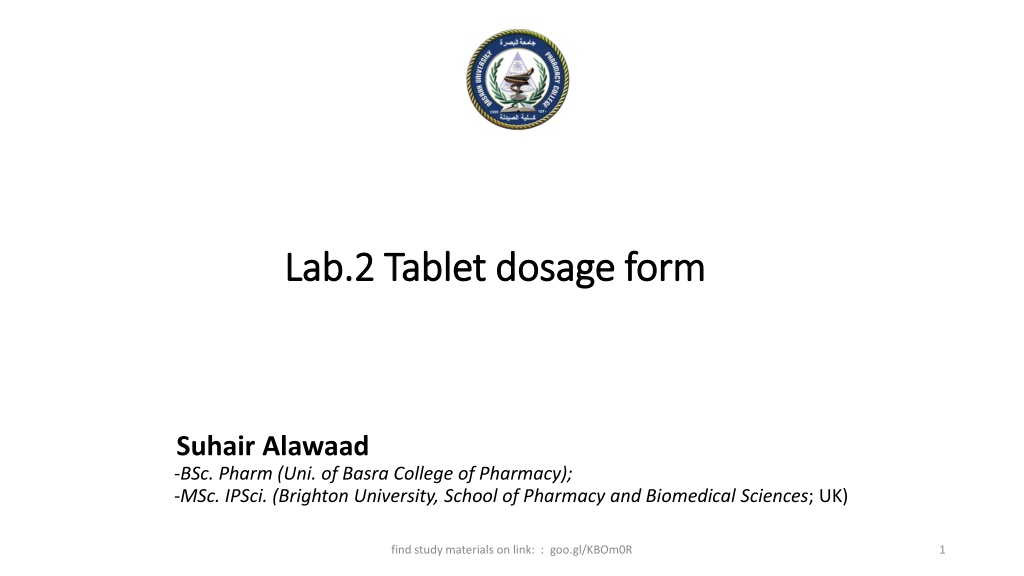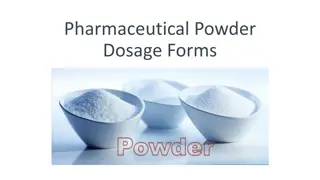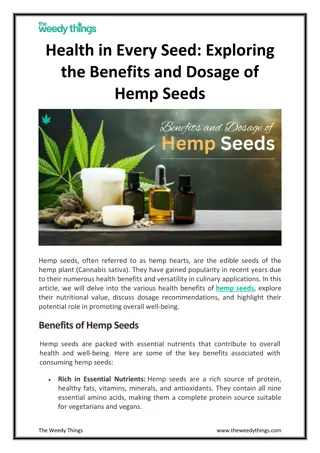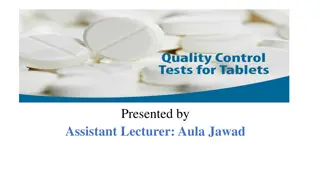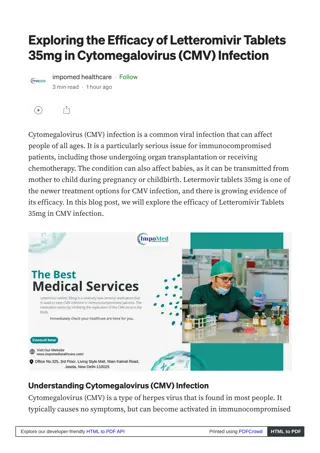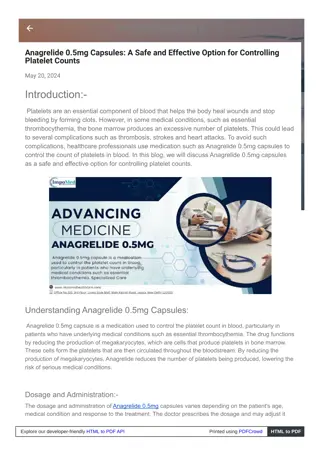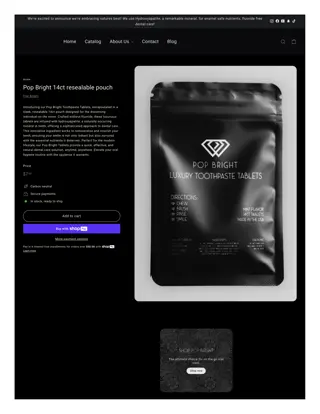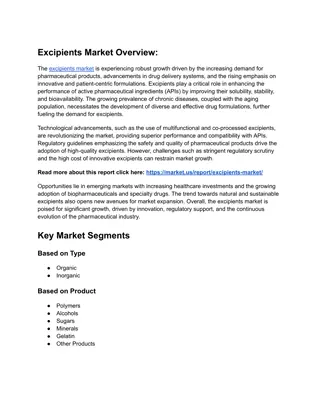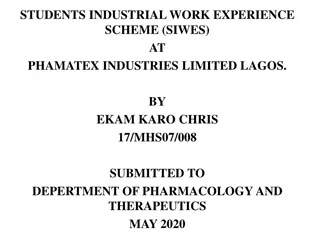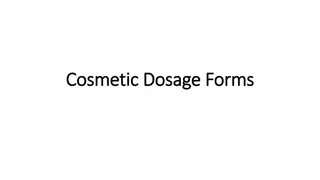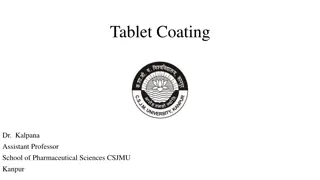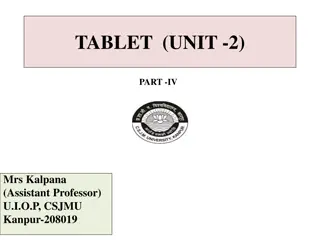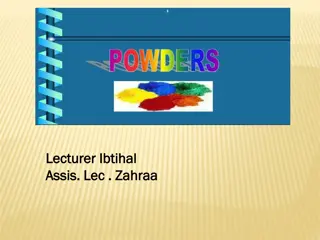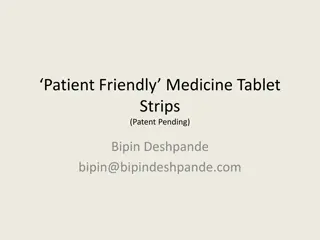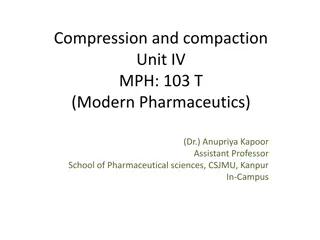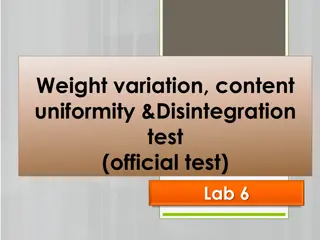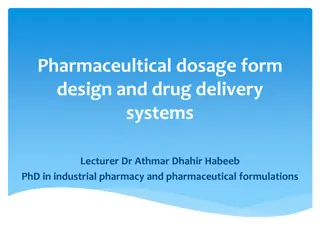Tablet Dosage Forms: Introduction and Excipients
Tablet dosage forms are solid units containing a single dose, commonly preferred due to patient acceptability and ease of manufacturing. Excipients, such as fillers and binders, play crucial roles in tablet formulation. Explore the importance of tablet excipients and their functions in pharmaceutical preparations.
Download Presentation

Please find below an Image/Link to download the presentation.
The content on the website is provided AS IS for your information and personal use only. It may not be sold, licensed, or shared on other websites without obtaining consent from the author.If you encounter any issues during the download, it is possible that the publisher has removed the file from their server.
You are allowed to download the files provided on this website for personal or commercial use, subject to the condition that they are used lawfully. All files are the property of their respective owners.
The content on the website is provided AS IS for your information and personal use only. It may not be sold, licensed, or shared on other websites without obtaining consent from the author.
E N D
Presentation Transcript
Lab.2 Tablet dosage form Lab.2 Tablet dosage form Suhair Alawaad -BSc. Pharm (Uni. of Basra College of Pharmacy); -MSc. IPSci. (Brighton University, School of Pharmacy and Biomedical Sciences; UK) find study materials on link: : goo.gl/KBOm0R 1
I Introduction ntroduction Tablet is a unit solid dosage which is usually prepared with the aid of suitable pharmaceutical excipients and it contains a single usual dose. find study materials on link: : goo.gl/KBOm0R 2
The Route of administration of tablets: The most common one is (????) find study materials on link: : goo.gl/KBOm0R 3
More than 50% of formulations are More than 50% of formulations are tablets. Why????? tablets. Why????? Patient acceptability due to: ( Portability, Hard to tamper with tablets, Easy to swallow, especially if coated.) Relatively easy to manufacture and package Provide accurate dosing Increased stability of the drug when compared to liquid dosage forms. Product identification is easy especially with use of imprints. Can be enteric coated or designed for delayed release. find study materials on link: : goo.gl/KBOm0R 4
Disadvantage (are few) Disadvantage (are few) Formulation difficulties, if drug resist compression. Some drugs have poor wetting or poor water solubility or poor dissolution which might affect the drug s bioavailability. Q/Suggest an alternative dosage form?? Bitter taste of the drug might require coating. Not suitable for liquid drugs. find study materials on link: : goo.gl/KBOm0R 5
Tablet Excipients Tablet Excipients : : What They are????? Excipients improve the physical properties of the tablet. Excipients includes: 1)Fillers (diluents) used to increase the bulk of the tablet . it is generally not feasible to make tablets with a weight of less than about 70 mg. It is essential that fillers be inert and stable . A - Soluble : lactose , sucrose , mannitol , sorbitol . B- Insoluble: calcium sulfate , dicalcium phosphate , tricalcium phosphate , starch , calcium carbonate Filler must be: Having good flowability and compressibility, Inert, cheap, tasteless, able to disintegrate find study materials on link: : goo.gl/KBOm0R 6
2)Binders : the substance that glue powders together and cause them to form granules are the binders or adhesives. They are either sugars or polymeric materials. Examples Water Ethanol , - Acacia mucilage (10-20%) and it gives hard ,friable granules , -Tragacanth mucilage (10-20%) , - Gelatin solutions (2-10%) , they are strong sdhesive ,use warm. -Starch mucilage (5-10 %) , one of the best general adhesieves ,use warm. Glucose syrup (25-50%) , strongly adhesive , tablet may soften in high humidity PVP(3-15%) Cellulose derivative (5-10 %)
3) Lubricants ,glidents and anti adherents : they prevent the most common problem during tableting.(the flow of granulation , the adhesion of material to the punches and dies , and release of the tablet from the press.) Lubricants : Are those agents that the friction between the tablet edge and die wall during the ejection cycle . e.g. magnesium stearate - Lubricants are usually added at the very last step before compression , since they must be present on the surfaces of the granules between them and the parts of the tablet press . Glidants : Are materials that improve the flow characteristics of granulation e.g. talc. Anti adherents : Function to prevent tablet granulation from sticking to faces of the punches and the die walls e.g. talc . find study materials on link: : goo.gl/KBOm0R 8
4) Disintegrants : Is added for the purpose of causing the compressed tablet to break apart when placed into an aqueous environment . Method of adding disintegrant : It is better to add it in two portions , one half is added to the powdered components before the wet granulation process and the remaining portion is added to the finished granulation just prior to the compression . This method hold that a disintegrent is required between the granules as well as within them Some of the commonly used disintegrant - Starch (5-20% w/w ) - Avicel (5-20 % w/w) - Algenic acid (5-10 %w/w) - Veegum (5-15 % w/w) - Bentonite ( 5-15 % w/w) 5)Preservatives 6)Flavouring agents 7)Film formers 8)Opacifiers and colours Q/Prescribe the function of each and give at least 2 examples for each one find study materials on link: : goo.gl/KBOm0R 9
Manufacturing method Manufacturing method 1. Direct compression The drug itself is compressible and/or it can be mixed with a filler that is compressible (e.g. lactose). Has a good flow properties 2. Dry granulation The powder mixture of the drug and excipients is granulated prior to compression. Granulation is by either methods: A. Wet granulation B. Dry granulation In all of these methods the active ingredient is usually mixed with other inactive ingredients (excipients). Excipients improve the physical properties of the tablet. find study materials on link: : goo.gl/KBOm0R 10
Direct Compression Direct Compression All the materials are blended together and sieved then compressed directly. Properties of directly compressed materials The API itself is compressible and/or it can be mixed with a filler that is compressible (e.g. lactose). API should have a good flow properties find study materials on link: : goo.gl/KBOm0R 11
Limitations of direct compression Limitations of direct compression 1. There are only Few crystalline substances such as sodium chloride, sodium bromide and potassium chloride that may compressed directly. 2. Most materials have low intermolecular attraction forces ( cohesion) which minimize compression. 3. Compression of single substance might produce very hard tablet which needs addition of other excipient(s). These excipients might affect on compressibility. 4. For small doses drugs, it is not practical to achieve a uniform blend from the API and the coarser diluent. Therefore, granulation is most suitable. find study materials on link: : goo.gl/KBOm0R 12
Limitations of direct Limitations of direct compression (continued) (continued) compression 5. Difference in particle size and bulk properties might lead to non uniformity in content, particularly, for low doses drugs 6. Interaction with diluent as for interaction between amine compounds and spry dried lactose 7. The dry conditions might build up a static charge which might negatively affect the mixing state. 8. It is suitable for only large doses drugs; however, the compressible drugs are limited find study materials on link: : goo.gl/KBOm0R 13
General procedure for direct compression General procedure for direct compression Blending of all ingredients Sieving through X mesh size Compression via tableting machine find study materials on link: : goo.gl/KBOm0R 14
Single Punch Tablet Single Punch Tablet Machines Machines Consist of hopper which deliver the powder blend into the die The die which gives the size and shape of the tablet The upper punch and lower punch are moving to fill the die and eject the tablet find study materials on link: : goo.gl/KBOm0R 15
Direct compression Direct compression Metronidazole 200 mg Lactose 100 mg Mg. Stearate 1% Prep. 10 tablets 1.Weigh the required amount of metronidazole and lactose to prepare 12 tablets and mix them geometrically. Avoid grinding (why??). 2.Pass through 30 mesh size sieve. (Why?) 3.Add the required amount of lubricant and mix for not more than 5 minutes. (Mixing time is critical should not exceed 5 min. (explain). 4.Compress directly with tableting machine. find study materials on link: : goo.gl/KBOm0R 16
